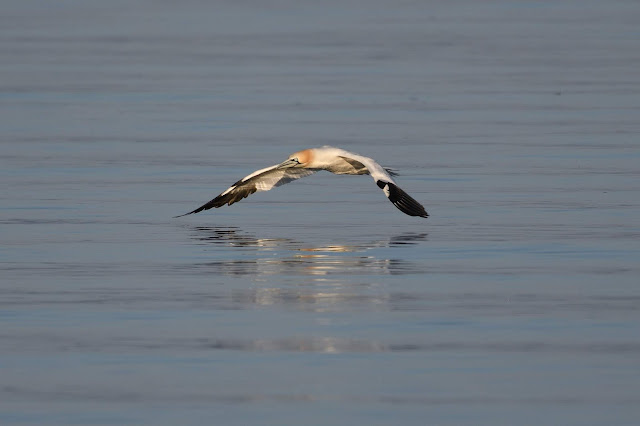Gannets
One of the largest seabirds of the North Atlantic, the gannet is spectacular as it plunges into the sea in pursuit of fish.
All images taken with my Nikon D500 and Nikon 200-500 f5.6 lens.
 |
| Point of impact! |
The gannet is the largest seabird in the North Sea region. When it spreads its wings, it measures up to 1.5 meters in width. Gannets live up to 35 years and swim and fly almost their entire life in and above the sea, only coming on land to nest. In order to take flight, they need to catch a good wind under their wings. On land that would mean a running start, but gannets are too clumsy on land. That’s why they nest high up on steep coasts, where the strong seawind is forced upward against the rocky wall. All they need to do to take off is to spread their wings.
Gannets nest in colonies. The gannet colonies on the Scottish Bass Rock and Ailsa Craig have been around for centuries. The female first starts laying eggs at five years old. Both parents take turns brooding the egg in an unusual manner: using the warmth from their feet. The extra care is necessary, since gannets only lay one egg per year. The young is fed for three months. Juvenile gannets are easy to recognize by their grayish-brown plumage with white spots. They only get their fashionable adult plumage in their fifth year of life.
The gannet tracks its prey from the air and catches it by making a steep vertical dive. In order to seize its prey, the bird dives straight down into the water from a height of 30 meters. Folding its wings back and stretching its bill straight down, it reaches a speed close to 100 kilometers per hour, cleaving through the water surface like a living torpedo. The enormous blow is absorbed by a strengthened skull and a protective air cushion under the skin, a kind of airbag. Once under water it continues its hunt, first plunging through the first four meters and then swimming after the frightened fish up to a depth of 10 meters below the surface.
Just like other large seabirds, gannets are threatened by plastics and oil pollution in our oceans, as well as discarded fishing lines, fishing nets, etc. Other fishing techniques can also form a threat to gannets. More recently, gannet populations in Scotland have come under threat from ever increasing wind farms, which account for thousands of deaths every year.
Taking off from land or water is not easy for gannets, Their webbed feet are great for propelling them undrwater, but they tend to trip over themselves when walking or running. On a calm day, they seem to cope quite well, but with a heavy swell, these birds can seriously struggle, resulting in some birds getting washed up on shorelines.
Taking off from land or water is not easy for gannets, Their webbed feet are great for propelling them undrwater, but they tend to trip over themselves when walking or running. On a calm day, they seem to cope quite well, but with a heavy swell, these birds can seriously struggle, resulting in some birds getting washed up on shorelines.
 |
| lots of flapping and splashing |
 |
| is followed by lots more flapping and splashing |
 |
| nearly there........ |
 |
| lift off! |
Once airborn, these graceful fliers are a sight to behold and travel many hundreds of miles on fishing trips. Recently, a gannet was fitted with a GPS tracker, which showed a round trip of over 500 miles!
If you enjoy reading my photoblogs, please share them with your friends and 'subscribe', by clicking on the link above.







Beautiful set of photos and the first one is amazing. So sad about the fishing lines, plastic etc, man has a lot to answer for!! We drive back on Tuesday/Wednesday weather permitting, so hope to see you next month. Hope all is well Diane and Nigel.
ReplyDelete